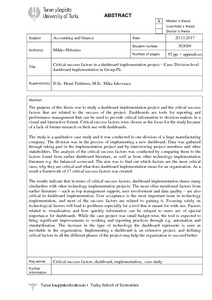Critical success factors in a dashboard implementation project : Case: Division-level dashboard implementation in Group Plc
Helenius, Mikko (2017-12-11)
Critical success factors in a dashboard implementation project : Case: Division-level dashboard implementation in Group Plc
Helenius, Mikko
(11.12.2017)
Turun yliopisto
avoin
Julkaisun pysyvä osoite on:
https://urn.fi/URN:NBN:fi-fe2017121155686
https://urn.fi/URN:NBN:fi-fe2017121155686
Tiivistelmä
The purpose of this thesis was to study a dashboard implementation project and the critical success factors that are related to the success of the project. Dashboards are tools for reporting and performance management that can be used to provide critical information to decision-makers in a visual and interactive format. Critical success factors were chosen as the focus for the study because of a lack of former research on their use with dashboards.
The study is a qualitative case study and it was conducted in one division of a large manufacturing company. The division was in the process of implementing a new dashboard. Data was gathered through taking part in the implementation project and by interviewing project members and other stakeholders. The analysis of the critical success factors was conducted by comparing them to the factors found from earlier dashboard literature, as well as from other technology implementation literature e.g. the balanced scorecard. The aim was to find out which factors are the most critical ones, why they are critical and what does dashboard implementation mean for an organization. As a result a framework of 17 critical success factors was created.
The results indicate that in terms of critical success factors, dashboard implementation shares many similarities with other technology implementation projects. The most often mentioned factors from earlier literature – such as top management support, user involvement and data quality – are also critical in dashboard implementation. User acceptance is the most important issue in technology implementation, and most of the success factors are related to gaining it. Focusing solely on technological factors will lead to problems especially for a tool that is meant for wide use. Factors related to visualization and how quickly information can be relayed to users are of special importance for dashboards. While the case project was small budget-wise, the tool is expected to bring significant improvements to working and reporting practices through e.g. automation and standardization. The increase in the type of technology the dashboard represents is seen as inevitable in the organization. Implementing a dashboard is an extensive project, and defining critical factors in all the different phases of the project may help the organization to succeed better.
The study is a qualitative case study and it was conducted in one division of a large manufacturing company. The division was in the process of implementing a new dashboard. Data was gathered through taking part in the implementation project and by interviewing project members and other stakeholders. The analysis of the critical success factors was conducted by comparing them to the factors found from earlier dashboard literature, as well as from other technology implementation literature e.g. the balanced scorecard. The aim was to find out which factors are the most critical ones, why they are critical and what does dashboard implementation mean for an organization. As a result a framework of 17 critical success factors was created.
The results indicate that in terms of critical success factors, dashboard implementation shares many similarities with other technology implementation projects. The most often mentioned factors from earlier literature – such as top management support, user involvement and data quality – are also critical in dashboard implementation. User acceptance is the most important issue in technology implementation, and most of the success factors are related to gaining it. Focusing solely on technological factors will lead to problems especially for a tool that is meant for wide use. Factors related to visualization and how quickly information can be relayed to users are of special importance for dashboards. While the case project was small budget-wise, the tool is expected to bring significant improvements to working and reporting practices through e.g. automation and standardization. The increase in the type of technology the dashboard represents is seen as inevitable in the organization. Implementing a dashboard is an extensive project, and defining critical factors in all the different phases of the project may help the organization to succeed better.
